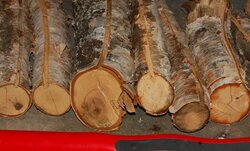Hello everyone, I have purchased a garn to heat my house this year and have been cutting lots of standing dead ash for the boiler. In the garn manual it says that 24-32 inch long wood is best, anything under 7 inches in diameter dosent need to be split. I had a small pile of maple that I cut last spring just for "camp wood" and I found a two foot long pice that was about 4" in diameter. I decided to split it open and test it with my moisture meter. It read 34%. Now granted this piece was just laying on the ground. But
My question is what is everyone's thoughts on rounds that long that aren't split? I don't want to burn wet wood in the garn but I also have read that if I split the small pieces there may be too much surface area of wood causing the garn to not burn right. Any thoughts?
My question is what is everyone's thoughts on rounds that long that aren't split? I don't want to burn wet wood in the garn but I also have read that if I split the small pieces there may be too much surface area of wood causing the garn to not burn right. Any thoughts?


 , if you want rounds that dry much quicker try 12 inch but I split everthing below about 5 inch.
, if you want rounds that dry much quicker try 12 inch but I split everthing below about 5 inch.